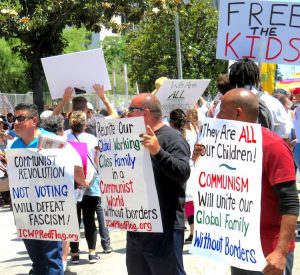Organize communist collectives here ♦ A bit of history here ♦

Organize Communist Collectives for a World without Borders
“Don’t lock the children in cages!” shout the many people outraged with the treatment of children detained by the US Border Patrol.
The stories of the thousands of children separated from their parents are heartbreaking. Some parents, due to racism and bureaucratic carelessness, don’t even know where their children are. But this is normal in a capitalist world that treats working-class children and adults as expendable.
These children and adults are fleeing the misery and crisis created by the local and imperialist bosses. Borders and walls are created by both Democratic and Republican US capitalists—and by capitalists worldwide.
One comrade commented, “My cousin paid $20,000 to bring her and her three youngest children to the US. But they left her in Matamoros, Mexico. Only two of her children made it through. Now she is in debt and unable to cross the border.”
This situation will continue to repeat itself, millions of times around the world. In a communist world without borders, no one, including children, will be committing a crime for seeking a better life.
Even if a few thousand manage to improve their individual situations by finding jobs in this society designed to produce for profit, billions more will still be killed by starvation, bombs, bullets, or preventable diseases.
This capitalist profit system represents the good life for a few millionaires, but misery and death for the billions of wage slaves.
The American dream is just that: a dream. Only when capitalism no longer exists can all our hopes be realized for a more harmonious world that works for the well-being of every living being. Not only of human beings, but of all animal and plant species.
That future must start now. We must organize ourselves into communist collectives, where we can discuss, plan, and write our thoughts about how each one can help solve a problem, about what solution we propose to each situation that comes our way.
These collectives are just the beginning of bigger decisions that will have to be made, such as when it is time to take power and eliminate the capitalist system.
The vision of a new communist world without borders or exploitation gives us strength to continue and make communist revolution a reality.
Comrade in Los Angeles (USA)
A Little Bit of History
Recently I revisited Cool Gray City of Love, by Gary Kamiya. This book explores the city of San Francisco (USA) not only by points of interest and lovely views, but also by history.
Kamiya tells the history of the Western Addition. Before the 1906 earthquake and fire, this neighborhood was mostly middle-class descendants of immigrants from Europe. When the poorest workers and their families were displaced by the fire, many moved to the Western Addition. The Victorian homes were divided into rooms and rented out to workers who were Filipino, Mexican American, African American, and Japanese. The Western Addition became one of the most diverse neighborhoods in the US.
That changed during World War II. After Pearl Harbor, all Japanese people in San Francisco were rounded up and forcibly relocated to prison camps all over the western US.
At the same time, the Bay Area shipyards needed workers to build warships. Thousands of Black workers and their families moved to San Francisco to fill those jobs. Due to a shortage of housing, and racist San Francisco landlords who would not rent to Blacks, the housing that Japanese families were forced out of became home to these workers.
The Black population of San Francisco grew from 4,846 in 1940 to 43,502 in 1950. The neighborhood that used to be called Japantown became the Fillmore district. Black-owned businesses flourished, and the sounds of modern jazz and bebop filled the clubs and record shops.
After the war, racism and fear prevented many internees from moving back to their former neighborhoods. A government report stated that “the release of Japanese from War Relocation Authority Camps will be the cause of friction and racial clashes when the Japanese arrive back in California.”
The Japanese American Citizens League, which cooperated with the government by identifying Japanese Americans who fought back against the incarceration, took the same position.
In 1945, sixty members of the AFL Machinists Union threatened to strike when a Japanese American mechanic was hired at the Municipal Railway. The day he bravely showed up to work, the machinists put down their tools.
However, two drivers stood up to defend him. One was African American, and one was Native American. Finally, another worker [probably white but the book doesn’t say], a war hero, spoke up: “I didn’t go out to fight in the Pacific so people with differently colored skin would be discriminated against when I got home!” The Machinists voted to stay on the job.
Despite the bosses’ plans to pit one group of workers against the other with racism, within two years, the population of Japanese Americans resettling in the neighborhood was back to its old size.
The growing membership in the left-led CIO and the Communist Party played a big part in labor organizing and social reforms in San Francisco and Oakland. A general strike took place in Oakland in 1946, led mainly by women.
Please contribute if you know more about the role of Bay Area communists during this period.
Comrade in the USA

